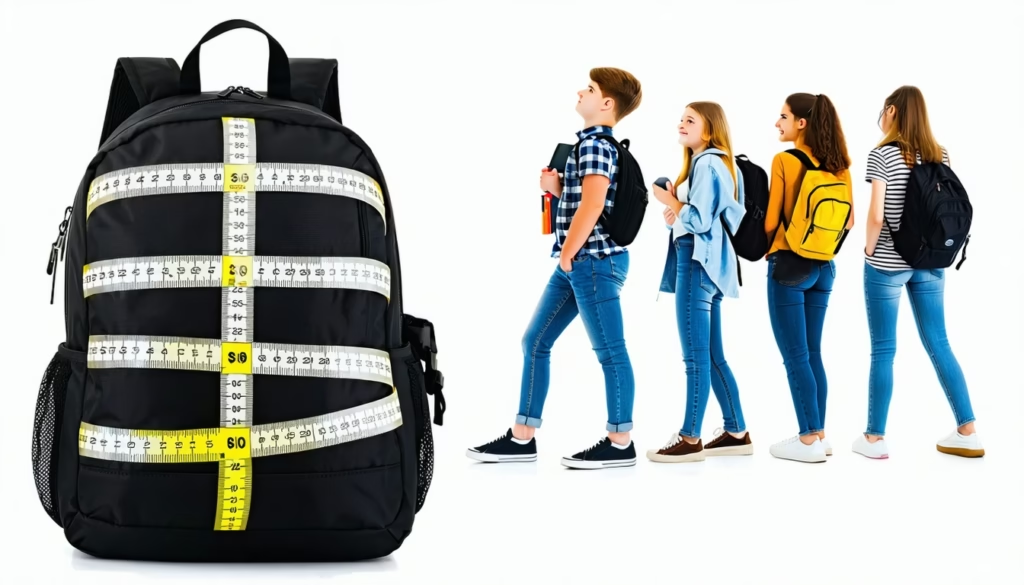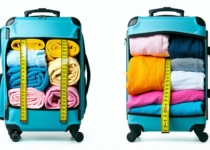How to Measure Fit: Choosing a Backpack That Doesn’t Slouch

Finding the Perfect Fit: Your Guide to Choosing a Backpack
Picking out the perfect backpack is super important, especially for school and college gals. The right bag can make or break your daily hustle, whether you’re lugging books or packing for a trip.
Why the Right Fit Matters
The right backpack spreads weight nice and evenly across your shoulders and back, cutting down on strain, which means less chance of getting hurt. The wrong fit can leave you hunched over and dealing with pesky back pain. Figuring out your size will help you say goodbye to unnecessary aches and hello to comfy bag days.
Think About This Before Measuring
Before you go all in on measurements, think about these few things to help pick the best bag:
-
Body Type: How tall you are and your build can totally change what size or style of backpack works. Taller folks might go for longer bags, while shorter ones could benefit from smaller options. Curious about what suits teens over 54 inches? Check out this guide.
-
What You’re Hauling: Are books, a laptop, or sports stuff on the list? Maybe you need extra pockets for all that organizing. Dive into benefits of multiple compartments in backpacks to get the lowdown.
-
Adjustability: Adjustable doohickeys like shoulder straps and waist belts give you a custom fit. We’ve got tips on how to tweak those backpack straps for max comfort.
-
Material and Style: Lightweight packs mean easy hauling. Look for stuff with mesh straps if you want to keep it cool and breezy.
| Thing to Consider | What to Think About |
|---|---|
| Body Build | Your height and build decide the fit |
| What’s Inside | Books, laptops, sports stuff |
| Adjustable Features | Seek straps and belts you can tweak |
| Material & Style | Look for light, breathable, comfy-feel features |
Keeping these in mind will have you snagging a backpack that fits right, stays put, and doesn’t weigh you down. Need more info on keeping school stuff in check? Check out our article on organize school backpacks teenage girls.
Measuring Your Backpack Fit
Finding the right backpack is like finding the perfect pair of jeans—it’s gotta fit just right for comfort and support. Especially if you’ve got loads of books and gear to haul around. Let’s get you geared up with this guide on how to measure your backpack fit correctly, so it sits pretty on your back.
Tools You’ll Need to Measure Up
Before diving in, here’s your checklist for what you need to grab:
| What You Need | What It’s For |
|---|---|
| Measuring Tape | To get your torso and other important sizes |
| Paper and Pen | To jot down all those super-important numbers |
| A Buddy | To help with measurements that require an extra hand |
How to Measure Your Backpack Fit
- Get Your Torso Length:
- Stand up nice and straight. Have your buddy measure from the knobby bit at the base of your neck down to where your hips start. This helps pick the right pack.
- Jot it down in inches because details matter.
- Find Your Waist Size:
- Wrap the measuring tape around where you naturally bend (your waistline). This is for choosing a backpack with a supportive waist strap.
- Capture that number!
- Shoulder Span:
- Measure across from one shoulder joint to the other. This one’s all about making sure the straps aren’t leaving you wishing for a bigger shirt size.
- Note it down.
- Put the Backpack to the Test:
- Once you’ve got a backpack candidate, try it on with something similar to what you’ll be carrying. Tug and pull those straps until it fits just right—no sagging allowed.
- Make sure it feels like a part of your body, not something tagging along reluctantly.
Hopefully, these steps guide you to a backpack that fits like a glove. Need more tips? Check out our guide on what size backpack fits teenage girls over 54. A backpack that hugs you right can really make a difference in your daily school hustle!
Evaluating Shoulder Straps
Picking the right shoulder straps can keep your backpack comfy and easy to lug around all day long. Here’s a quick-and-friendly guide to get those straps just right for you.
Proper Adjustment Techniques
When you’re tweaking those shoulder straps, you’re aiming for a cozy fit without giving your shoulders any grief. Here’s how you can nail that perfect adjustment:
- Loosen Up: Kick things off by loosening those shoulder straps before you throw the backpack on.
- Suit Up: Slip the backpack on and let it find its groove on your back.
- Find Your Height: Ensure the straps sit just right—not too high, not too low. Generally, they should rest where your shoulders begin.
- Tighten Up: Pull the straps snug so the backpack hugs your back nice and close, without dragging or wobbling.
- Flex Check: Make sure you can swing your arms freely. If you feel like a robot, ease off the straps a notch.
| Strap Positioning | Where It Should Be |
|---|---|
| Too High | Up above the shoulder line |
| Just Right | Right at the shoulder start |
| Too Low | Hanging below the shoulder line |
Keeping it Cozy and Supportive
Comfort’s the name of the game, especially when you’re toting the backpack for ages. Here’s how to make sure those shoulder straps have your back:
- Cushioning: Choose straps that are cushioned to ease the load on your shoulders. Look for padding that won’t make the backpack bulky but will keep your shoulders happy.
- Width Matters: Wider straps help spread the weight, making it gentler on your shoulders. Aim for straps a couple of inches wide.
- Material Know-How: Opt for breathable fabrics like mesh or foam, which can fend off sweat and irritation when the mercury climbs.
- Easy Adjusting: Go for a backpack with straps that adjust without a struggle. Handy if you want to switch from school to chilling with pals.
By keeping an eye on these strap details, you can up your backpack game comfort-wise. If you’re itching for more tips on strap magic, swing by our article on how to adjust backpack straps for comfort.
Assessing the Torso Length
Making sure your backpack fits your torso just right is key to staying comfy and upright. Let’s help you figure out your perfect fit and tweak your backpack to suit you.
Determining Your Ideal Torso Length
Learning your torso length boils down to measuring from the base of your neck to the top of your hips. This is your magic number for picking a backpack that hugs you just right. Here’s how you do it:
- Stand tall and find your hip bones.
- Grab a soft measuring tape and measure from where your collarbones meet straight on down to the top of your hips.
- Jot down this number to match with backpack sizes.
| Measurement Range | Backpack Size |
|---|---|
| 14″ – 16″ | Small |
| 16″ – 18″ | Medium |
| 18″ – 20″ | Large |
If you’re scratching your head about sizes, check out this handy guide on what size backpack fits teenage girls over 54.
Adjusting Backpack Length Accordingly
Now that you’ve got your mojo (torso length), let’s tweak your backpack to fit like a glove. Most backpacks have straps and harnesses you can fiddle with.
- Loosen the Straps: First, loosen those shoulder straps all the way. This makes adjusting a breeze.
- Pull the Straps: Tighten them up to sit nicely on your shoulders. Your backpack should rest right at hip level—not floating in the air or dragging down.
- Check for Comfort: Stand up straight with the backpack on. It should feel cozy without pulling on your shoulders or neck.
If you’re still sagging or slooching (yes, that’s a thing), peek at our article on how to adjust backpack straps for comfort for some extra pointers.
Spending a bit of time now to get everything just right ensures your backpack fits snugly, giving you the back-up you need for school and life.
Waist Belt Fit and Support
So you’re shopping for a new backpack, huh? Don’t sleep on the waist belt! This little feature can make a big difference in comfort, especially when you’re lugging around heavy gear. Think of it as the unsung hero of your backpack.
Benefits of a Waist Belt
Why bother with a waist belt, you ask? Well, it’s like having a helpful buddy that does the heavy lifting, taking a load off your shoulders, literally. Here’s why you’ll want your backpack with this nifty feature:
| Benefit | What’s in It for You |
|---|---|
| Weight Distribution | Puts some weight on your hips, so your shoulders don’t have to do all the work. |
| Increased Stability | Keeps that backpack snug to your back, so it doesn’t swing around like a yo-yo. |
| Enhanced Comfort | Takes the ouch out of shoulder and back strain by letting your core muscles pitch in. |
| Better Posture | Helps keep your spine upright, so you don’t turn into Quasimodo after a long hike. |
Fitting and Adjusting the Waist Belt
Getting your waist belt to fit just right is like finding your shoe size—it’s a must for peak comfort. Here’s the lowdown on making sure your waist belt is working its magic:
-
Locate the Belt: Check out the bottom of your backpack for the waist belt. That’s your target.
-
Put on the Backpack: Adjust those shoulder straps first so the pack sits nice and high on your back before messing with the waist belt.
-
Position the Belt: Get the belt to sit on your hips, not your waist. Think hipster style—snug but not so tight you’re cutting off circulation.
-
Adjust the Tightness: Yank on those straps to get the belt snug. You want it to stay put but not turn into a torture device.
-
Check for Movement: Have a little wiggle test. You should be able to bust a move without the belt slipping around or the backpack feeling like it’s gonna slide off.
Follow these tricks to get that waist belt just right, and your backpacking adventures will be way more chill. For a backpack fit that says goodbye to the slouch, maybe check out some pro-tips on how to keep your pack straight and tight.
Load Distribution and Stability
Carrying your backpack with the right balance is absolutely essential not just for comfort, but for ensuring you don’t end up walking like a human comma! Keeping things in order can stop your pack from turning into a runaway train sliding off your shoulders.
Why Spread the Weight?
So, why’s it such a big deal to have your backpack weight sitting pretty? Well, sorting your stuff just right makes lugging it around a whole lot easier, and helps you avoid that achy feeling as if your shoulders are auditioning for trapeze acts. Here’s the scoop:
- Say Bye to Ouchies: Balanced weight helps dodge those nasty back aches and any potential “ouch!” moments.
- Stay on Your Feet: Walking becomes easier when your load isn’t trying to pull you sideways.
- Move Like a Pro: Want to be nimble like a cat? Then make sure your backpack doesn’t throw a wrench in your spin or swerve.
| Load Effects | What It Does For You |
|---|---|
| Less Pain | Avoids discomfort and keeps injuries at bay |
| Balanced Steps | Keeps you from swaying like a ship in a storm |
| Freedom to Move | Spin and dodge with ease |
Keeping Your Backpack Steady
Sticking to a backpack strategy is the way to keep yourself sailing smoothly. Here are some basic rules for making sure everything stays on the up-and-up:
- Think Before Packing: Put heavier items closest to your back and stack lighter stuff farther out. This helps keep you from toppling over like a stack of Jenga blocks.
- See Your Backpack’s Potential: Those pockets and compartments? Use ’em! They’re not just for decoration; they help balance everything out.
- Adjust Those Straps!: Cool kids adjust their straps, y’know! Tighten those shoulder straps and waist belt snugly. Your bag shouldn’t be boogieing on your back. Need a hand with this? Peek at our guide on how to get those straps just right.
- Don’t Carry a Rock Collection: Pack only what you need. No use in carting around your life’s possessions! Traveling light makes life sweet.
Follow these backpack wisdom nuggets, and your trekking days will be a blissful breeze. Keep yourself comfy and upright as you hop over to class or meet up with friends. If you want more on mastering pack zen, check out our tips on how to organize school backpacks for savvy teens.
Checking for Slouch-Free Fit
Picking the right backpack is the difference between strolling through your day with ease and getting bogged down like a pack mule. A good fit ain’t just about style—it’s a ticket to comfortable hauling. Let’s walk through how to spot a backpack that stays put and doesn’t fight with your posture.
Signs of a Well-Fitted Backpack
Knowing if your backpack is doing its job? Here’s what to look for:
| Sign | Description |
|---|---|
| Shoulder Straps Sit Flat | These should sit sweetly on your shoulders, giving your neck a break from unwanted pressure. |
| Backpanel Aligns with Spine | The backpack’s back should feel as custom-fit as a hug—not a nag. |
| Load is Close to the Body | Your pack should be snug like an old friend, keeping the weight near you, not dragging behind. |
| Waist Belt is Engaged | If there’s a waist belt, it better be chilling on your hips, ready to redistribute weight and make life easier. |
If your bag’s hitting these notes, high five! You’re golden. If not, let’s tweak it until it is.
Adjustments to Eliminate Slouching
To say goodbye to the slouch once and for all, try these:
-
Tighten Shoulder Straps: Nah, don’t cut off circulation, but cinch them enough so your pack holds tight without playing hard to get.
-
Adjust the Load Lifters: Got those nifty straps above your shoulders? Pull ’em in—get that bag snug like it’s your better half.
-
Use that Waist Belt: If your bag’s got one, don’t let it dangle. Strap it on and let it help balance the weight, shaking off some shoulder duty.
-
Play with Backpack Height: If adjustable, set your bag’s height like a pro—no sagging means better weight distribution.
| Adjustment | Effect |
|---|---|
| Tightening Shoulder Straps | Keeps you upright, letting you glide smoothly with your gear. |
| Adjusting Load Lifters | Stabilizes your center, making your load feel lighter. |
| Engaging Waist Belt | Relieves shoulder protest, lightening your sense of the pack. |
| Adjusting Backpack Height | Perfects weight sharing, upping the comfort level. |
Locking down these tweaks means your backpack isn’t just along for the ride; it’s a partner. You’ll breeze through halls and paths without a hitch. Got more fab packing tricks? Catch our guide on organize school backpacks teenage girls. Happy hauling!
Trial and Error: Testing Your Backpack Fit
Finding the right backpack fit can feel like a bit of a science project, but once you get it right, it’s like hitting the sweet spot. Playing around with how your backpack sits when loaded with your stuff is a must to make sure it doesn’t become a pain in the back—literally.
Importance of Testing Different Loads
Grab all the stuff you’d usually lug around—like textbooks, tech gear, and those random bits and bobs you carry just ’cause you can. Throw ’em in to figure out if your backpack gives a good hug to your gear or if it turns into a torture device. Here’s a handy dandy list showing the weight of the usual suspects so you know what kind of load you’re dealing with:
| Item | Weight (lbs) |
|---|---|
| Textbook | 2 to 5 |
| Laptop | 3 to 5 |
| Notebooks | 1 to 2 |
| Water Bottle | 1 to 2 |
| Personal Items | 1 to 3 |
Stuff your backpack with these in different combos and see how your shoulders and hips feel about it.
Final Adjustments for Ultimate Comfort
After testing a bunch of different loads, it’s time to tweak your pack for that butter-like comfort. Here are some pro tips:
-
Shoulder Straps: These bad boys shouldn’t strangle you or hang loose. You want them just right so you can lift them a smidge without pulling a muscle. If you’re scratching your head about strap science, peek at our guide on how to adjust backpack straps for comfort.
-
Torso Length: Got a backpack with fancy adjustable torso lengths? Tweak it until it feels like it was tailor-made for you. A snug torso fit keeps the pack close, avoiding the slump monster. Head over to our section on assessing the torso length for some hacks.
-
Weight Distribution: Is the load equally chilling on both sides? If one side’s ready to crash, you might want to do some rearranging. It’s all about keeping balanced and not walking like you’re doing a one-sided dance.
Testing out your backpack with your typical stash and fiddling with the settings can make all the difference in comfy carrying. Get ready to find that backpack that’s just right for you. And hey, for organizing ninja-level tips, check out our article on organizing school backpacks for teenage girls.


